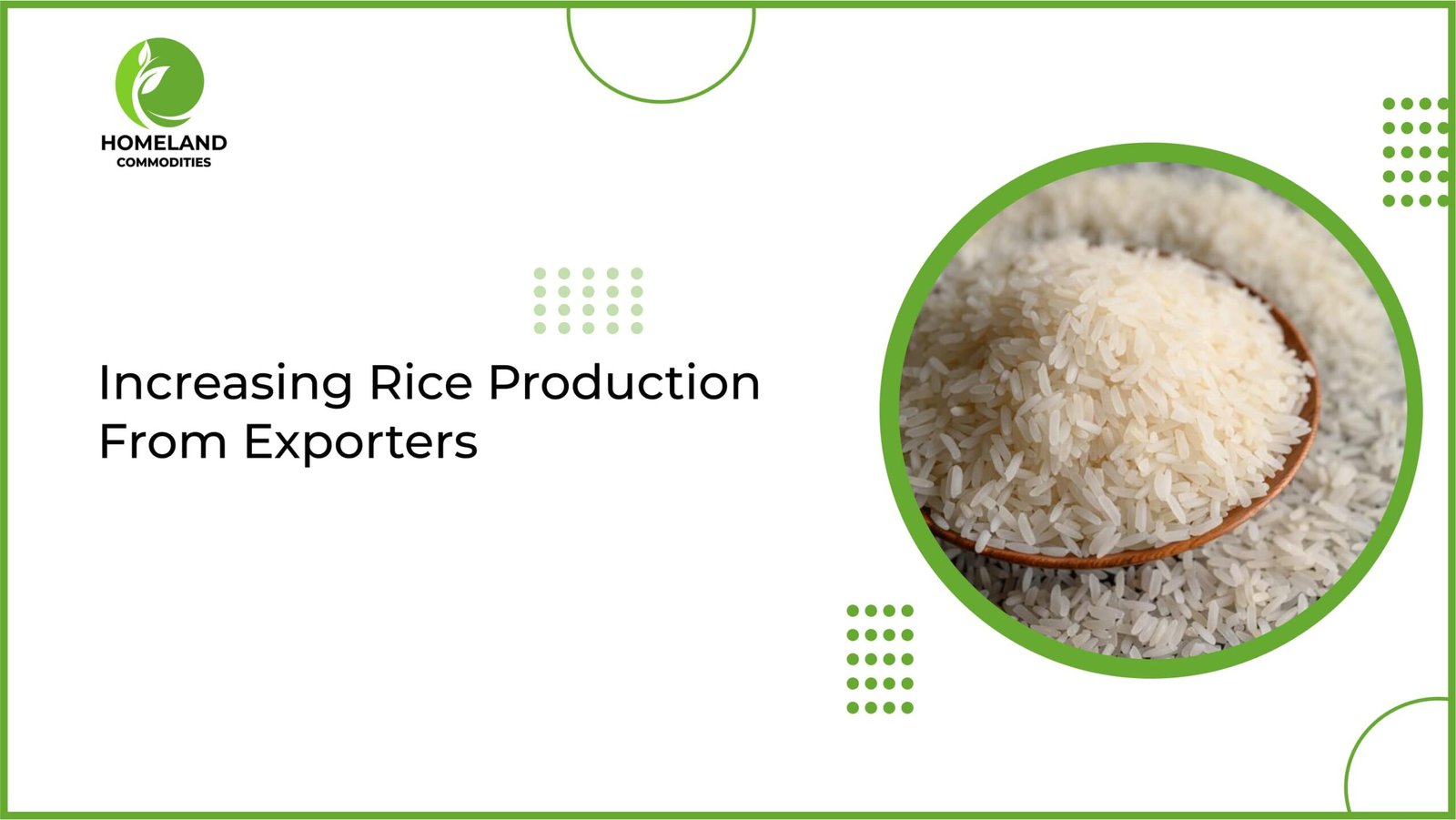Increasing Rice Production for Exporters
Rice is a vital global commodity and a staple food for billions of people. For exporters aiming to boost their rice production and secure a stronger position in the international market, a strategic and multi-faceted approach is essential. This article delves into the various strategies and practices necessary to increase rice production effectively, focusing on advancements in technology, infrastructure improvements, and marketing tactics.
Understanding the Global Rice Market
Overview of the Global Rice Trade
The global rice market is characterized by a diverse range of producers and consumers. Major rice-producing countries include China, India, and Thailand, while significant importers are located in regions such as Sub-Saharan Africa and the Middle East. Understanding global market dynamics, including supply-demand balances, pricing trends, and trade policies, is crucial for exporters aiming to navigate this competitive landscape.
Key Export Markets and Trends
To maximize export potential, exporters must identify and analyze key markets. This involves studying specific market demands, such as preferred rice varieties and quality standards. For instance, some markets may favor aromatic varieties like Basmati, while others might require long-grain or short-grain types. Staying abreast of emerging market trends, such as increasing demand for organic or sustainably produced rice, can provide exporters with a competitive edge.
Enhancing Rice Yield
1. Modern Agricultural Techniques
Modern agricultural techniques are pivotal in increasing rice yields. These techniques include:
- Precision Farming: Utilizing GPS and GIS technology to optimize planting, irrigation, and fertilization. Precision farming helps reduce input costs and increase productivity by targeting specific areas of the field.
- Advanced Irrigation Systems: Implementing modern irrigation methods such as drip and sprinkler systems allows for efficient water use, reducing the need for traditional flooding methods and conserving water resources.
- High-Yielding Varieties: Research and adoption of high-yielding, disease-resistant rice varieties can lead to substantial yield increases. Hybrid varieties and genetically modified strains are examples of innovations that enhance productivity.
2. Soil Health and Fertility Management
Maintaining soil health is fundamental to achieving high rice yields. Effective soil management practices include:
- Soil Testing: Conducting regular soil tests to determine nutrient levels, pH, and soil composition. This information guides the application of fertilizers and soil amendments.
- Integrated Nutrient Management: Combining organic and inorganic fertilizers to improve soil fertility and crop growth. Practices such as composting and green manuring can enhance soil structure and nutrient availability.
- Crop Rotation: Implementing crop rotation practices to prevent soil depletion, manage pests, and improve soil health. Rotating rice with legumes or other crops can enhance soil fertility and reduce pest pressures.
3. Pest and Disease Management
Managing pests and diseases is crucial to safeguarding rice crops. Key strategies include:
- Integrated Pest Management (IPM): Employing a combination of biological, cultural, and chemical methods to control pest populations in an environmentally sustainable manner.
- Disease-Resistant Varieties: Using rice varieties bred for resistance to common diseases, such as blast and sheath blight, can reduce the need for chemical treatments and increase overall crop health.
Research and Development
1. Role of Universities and Research Institutions
Collaboration with universities and research institutions can drive innovations in rice production. These partnerships can lead to:
- Development of Improved Varieties: Research institutions can develop new rice varieties with enhanced traits, such as higher yields, better quality, and greater resistance to pests and diseases.
- Innovative Farming Techniques: Research on new farming practices, technologies, and tools can lead to more efficient and sustainable rice production methods.
2. Development of New Rice Varieties
Focusing on the development of new rice varieties can help meet market demands and increase export potential. For example:
- Open-Pollinated Aromatic Extra-Long Grain Varieties: Developing these varieties can cater to markets with a preference for aromatic and high-quality rice, such as Basmati rice.
- Extra-Long Grain Hybrid Varieties: Producing hybrid varieties with superior traits can help create a large export surplus, especially in regions like Punjab.
Improving Rice Quality
1. Post-Harvest Handling and Processing
Effective post-harvest handling and processing are essential for maintaining and enhancing rice quality. Key practices include:
- Drying: Proper drying techniques, such as using mechanical dryers or sun-drying, help reduce moisture content and prevent spoilage.
- Milling: Advanced milling processes remove husks and polish rice while preserving nutritional content and minimizing breakage.
- Packaging: Using high-quality, moisture-resistant packaging materials helps maintain rice quality during storage and transport.
2. Quality Control Measures
Implementing stringent quality control measures throughout production and processing is crucial. This includes:
- Regular Quality Testing: Conducting tests for contaminants, such as pesticides and heavy metals, to ensure the rice meets safety standards.
- Compliance with International Standards: Adhering to quality standards set by organizations like the Codex Alimentarius ensures that rice products meet global market requirements.
Effective Irrigation Techniques
1. Traditional vs. Modern Methods
Traditional irrigation methods, such as flooding fields, are being supplemented or replaced by modern techniques that offer greater efficiency:
- Drip Irrigation: Delivers water directly to the plant roots, reducing water wastage and improving water use efficiency.
- Sprinkler Systems: Provides uniform water distribution over large areas, which can be particularly useful in areas with limited water resources.
Scaling Up Production
1. Investment in Infrastructure
Investing in modern infrastructure supports increased production capacity and ensures efficient operations. Key areas of investment include:
- Storage Facilities: Building adequate storage facilities helps prevent post-harvest losses and maintain rice quality.
- Processing Units: Upgrading processing facilities to handle larger volumes and improve processing efficiency.
2. Access to Financing and Resources
Securing financing and resources is essential for scaling up production. Strategies include:
- Exploring Funding Options: Seeking loans, grants, or subsidies from financial institutions or government programs to support expansion efforts.
- Government Support: Leveraging government initiatives, such as subsidies and infrastructure improvements, can provide additional support for scaling up rice production.
3. Training and Capacity Building
Investing in training and capacity building enhances the skills of farmers and production staff. This includes:
- Training Programs: Offering training on modern farming techniques, equipment use, and best practices to improve productivity and efficiency.
- Capacity Building Initiatives: Supporting initiatives that develop the skills and knowledge of production staff to drive improvements in rice cultivation.
Compliance with Export Regulations
1. Understanding Export Requirements
Navigating export regulations is crucial for successful international trade. Key considerations include:
- Customs Procedures: Understanding and complying with customs procedures and documentation requirements for each target market.
- Quality Certifications: Obtaining necessary certifications, such as ISO, HACCP, and organic labels, to meet market standards and enhance credibility.
2. Certification and Standards
Adhering to international standards and obtaining relevant certifications helps ensure market access and compliance. This includes:
- Quality Assurance: Implementing quality assurance practices throughout the production and processing stages to meet export requirements.
- Regulatory Compliance: Staying updated on regulatory changes and ensuring that all products meet the latest standards and requirements.
Marketing Strategies
1. Enhancing Market Visibility
Effective marketing strategies can significantly impact export success. Key tactics include:
- Branding and Promotion: Developing a strong brand identity and promoting unique selling points, such as quality, origin, and sustainability, to attract international buyers.
- Digital Marketing: Utilizing digital platforms and social media to reach potential buyers and showcase products to a global audience.
2. Government Support and Export Projections
Recent government initiatives have supported Pakistan’s rice export growth. For example:
- Subsidies and Infrastructure Improvements: Government support has contributed to increased rice exports by providing financial incentives and enhancing infrastructure.
- Export Projections: In 2023-2024, Pakistan’s rice exports are projected to reach 5 million metric tons, marking a historic milestone and reflecting the impact of recent support measures.
Future Trends and Innovations
1. Technological Advancements
Staying ahead of technological advancements can improve rice production processes. Key innovations include:
- Drones and AI: Using drones for aerial monitoring and AI for data analysis to optimize crop management and improve decision-making.
- Blockchain Technology: Implementing blockchain for tracking and traceability, ensuring transparency and quality throughout the supply chain.
2. Sustainability Practices
Embracing sustainability practices is increasingly important for meeting global demand for environmentally friendly products. This includes:
- Resource Efficiency: Adopting practices that reduce water and energy consumption, minimize waste, and promote sustainable farming techniques.
- Environmental Impact Reduction: Implementing measures to reduce the environmental impact of rice production, such as reducing greenhouse gas emissions and preserving biodiversity.
Conclusion
Increasing rice production for exporters requires a comprehensive approach that encompasses modern farming techniques, research and development, effective irrigation, and strategic marketing. By adopting these strategies and leveraging advancements in technology, infrastructure, and government support, exporters can enhance their production capabilities, meet global market demands, and achieve sustained success in the competitive rice industry.


